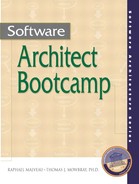Book Description
Become a great software architect—hands-on!
Define architectures that leverage today's best design patterns
Maximize scalability and technical flexibility
Lead your technical organization to successful implementation
Your hands-on "field manual" for becoming a great software architect!
This hands-on "field manual" gives developers the essential skills they need to survive and thrive as software architects! You'll find insightful, real-world coverage of everything from design patterns to prototyping, business case development to leadership.
Leading software architects Raphael Malveau and Thomas Mowbray share profound insights and practical solutions for all the key challenges of architectures using objects, components, and distributed Internet computing, showing how to avoid time-consuming pitfalls and costly errors. You'll master proven methods for:
Identifying the best architectural model for any project
Executing heavyweight or lightweight approaches to software architecture
Addressing scalability and long-term business flexibility
Making the most of abstraction, refactoring, and architectural prototyping
Leveraging superior design patterns to improve your implementations
With hands-on exercises, real-life war stories, and a take-no-prisoners attitude, Software Architect Bootcamp won't just help you become a great software architect: it'll help you become a true technical leader of your organization.
Table of Contents
- Copyright
- Preface
- Introduction
- Software Architecture: Basic Training
- Software Architecture: Going to War
- Software Architecture: Drill School
- Leadership Training
- Software Architecture: Jump School
- Communications Training
- Software Architecture: Intelligence Operations
- Software Architecture: Psychological Warfare
- Architecture Example: Test Results Reporting System
- Introduction
- Component Interoperability Challenge
- Target Architecture for the TRRS
- Target Enterprise Viewpoint
- Target Information Viewpoint
- Target Technology Viewpoint
- Prototype Implementation
- Prototype Computational Viewpoint
- TRRS Terminology
- Use Case Definitions
- Core Workflows
- Information Model
- Conclusions
- Design Templates and Examples
- Glossary of Software Architecture Terminology
- Acronyms
- Bibliography
